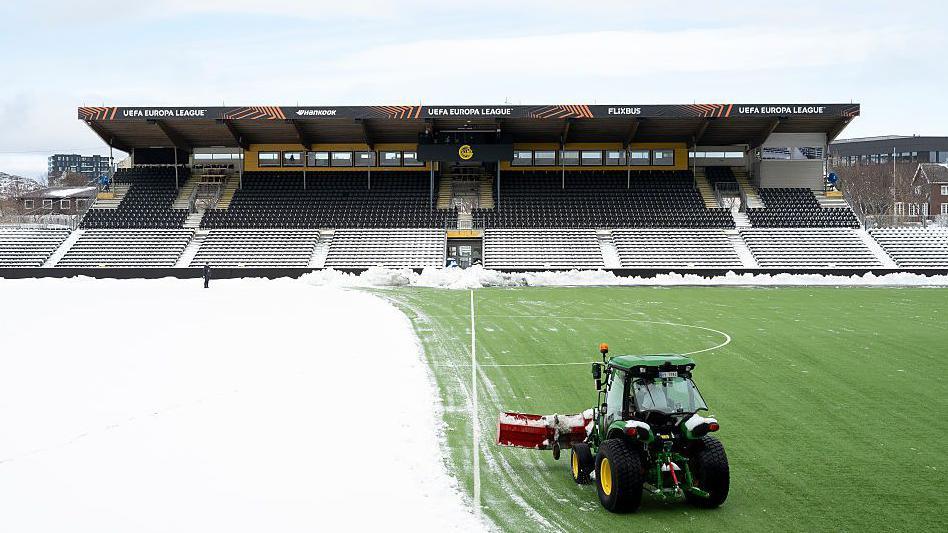When Lazio travelled to Bodo/Glimt for their Europa League quarter-final first leg last month they were greeted by a blizzard and a stadium covered in a blanket of snow.
Tractors with ploughs cleared the pitch so the game could be played, but the Italians still found the freezing conditions and artificial surface difficult as they were beaten by their Norwegian hosts 2-0.
They are not the first side to have struggled in Bodo – which is located 200km north of the Arctic Circle – and both Jose Mourinho and current Tottenham boss Ange Postecoglou will no doubt still have nightmares about the defeats they had there, while in charge of Roma and Celtic respectively.
Now it is Spurs’ turn to try to deal with the conditions in Thursday’s semi-final second-leg tie.
Cold & windy – what to expect in Bodo
To play this video you need to enable JavaScript in your browser.
As the Lazio players experienced – and Mourinho’s Roma too in 2021 with a 6-1 humbling in their Europa Conference League tie – playing football in Bodo can be a real test.
Sub-zero temperatures greeted them, but the good news for Tottenham is the weather is expected to be far more palatable for them.
Current forecasts suggest it is going to be around 5C and dry – so not a million miles away from what they are used to in England.
But other factors could provide a challenge.
Bodo’s coastal location, coupled with the open design of the 8,500 capacity Aspmyra Stadion, means it can be very windy during matches.
“We are not the sexiest team to meet,” Bodo/Glimt defender Jostein Gundersen told BBC World Service.
“It is not the biggest stadium, it is cold, it is windy. We have an advantage there because it is not the most fantastic place to play.
“We use the weather and the cold to our advantage. It is really difficult for the other teams to come here.
To play this video you need to enable JavaScript in your browser.
Spurs must adapt to ‘different football’ on artificial pitch
The weather may prove favourable for Tottenham, but they will still have to deal with playing on an artificial pitch.
For teams used to real grass they can find that the ball behaves differently on synthetic turf – it can move along the surface quicker and bounce differently. Bodo/Glimt’s players will be used to this, but Tottenham’s will not.
“It is different football [on an artificial pitch],” said midfielder Dejan Kulusevski.
“It is a different pitch, but in life, you have to do what you have to do to find a way to win and we have got to do that.”
Bodo defender Odin Bjortuft said: “Of course, playing here at home is a big advantage for us because I don’t think a lot of teams are prepared for what’s coming.
“The ball goes really fast when you play passes and it’s more difficult for defenders reaching attackers and getting contact with us. That’s what we benefit from in these games.
“It’s a big difference between artificial and grass in many ways, but the main key is that the ball goes so fast.”
Tottenham have already played on a similar surface this season – winning 3-0 at Tamworth in the FA Cup third round in January – and that will serve as a reminder of just how tough they found it.
Rivals Arsenal offer hope for Postecoglou’s side

In the Europa League this season, Porto, Besiktas, FC Twente and Olympiakos are among the teams to have come to Bodo and lost – highlighting the task Tottenham face.
Spurs, however, may take heart from fellow Premier League side and rivals Arsenal, who came to Bodo three years ago in the group stage of the Europa League and won 1-0 thanks to Bukayo Saka’s goal.
However, Bjortuft said his side have come a long way since that encounter.
“I wasn’t part of the team but we spoke a lot about this experience,” he added.
“A key factor for us is that the Arsenal game was early in Bodo/Glimt’s story for the last years. After the Arsenal game, we had a lot of European matches, big matches outside of Norway.
Related topics
- European Football
- Europa League
- Tottenham Hotspur
- Football
Source: BBC

Leave a Reply